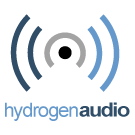Transparency
In psychoacoustics, transparency is the ideal result of lossy data compression. If a lossily compressed result is perceptually indistinguishable from the uncompressed input, then the compression can be declared to be transparent. In other words, transparency is the situation where artifacts are nonexistant or imperceptible.
Transparency depends most on the listener's familiarity with artifacts, and to a lesser extent, the compression method, bitrate used, input characteristics, listening conditions, and listening equipment. It also depends on the particular music piece or sound under examination. Some audio samples, when compressed with certain algorithms under certain conditions, are known to cause artifacts of a specific kind (see, for example, the samples from the Lame MP3 Encoder Quality and Listening Test Information web page).
Judging transparency can be difficult due to observation bias, in which subjective like/dislike of a certain compression methodology emotionally influences the listener's judgment. This bias is commonly referred to as placebo, although this use is slightly different from the medical use of the term.
By definition, there is no way to prove whether a certain compression methodology is transparent. To scientifically prove that a compression method is not transparent, one should either show that the particular compression method results in a measurable and easily perceived artifact, or use double-blind tests where the high anchor is the original uncompressed audio. For such tests the ABX method is normally used, and the audio samples should be chosen so as to make the detection of artifacts more obvious.
Non-lossy compression algorithms are assumed to be transparent: a non-lossy compression methodology should never introduce any artifact.
Transparency at the lowest possible bitrate also seems to be used as a measure of the quality or degree of sophistication and tuning of a lossy compression algorithm:
- MP3-encoded files are generally considered artifact-free at bitrates at/above 192kbps.
- Vorbis ogg files are supposedly artifact-free at bitrates at/above 160kbps.
- AAC- and Opus-encoded files, depending on the particular encoder implementation, are claimed to be artifact-free at lower bitrates than both Vorbis ogg and MP3.
With the present competition between compression formats (open and proprietary) and encoder implementations (GPL'd, proprietary), any claims of transparency at any given bitrate should always be considered with some skepticism.
